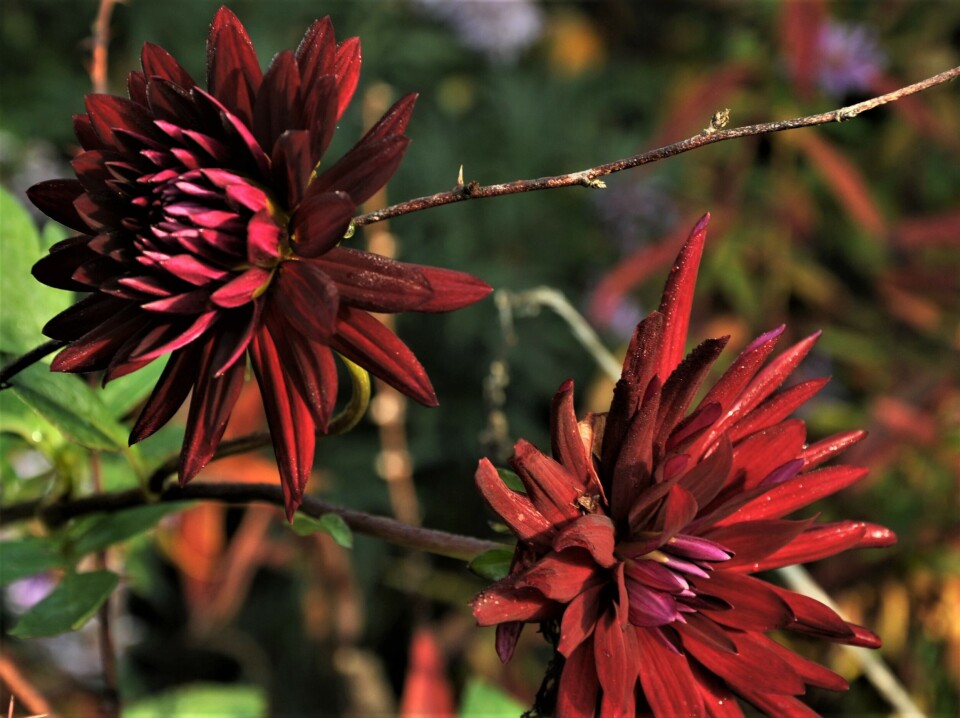-
France’s wild garlic season is here – but foragers should beware toxic lookalikes
Spring brings the fragrant plant to woodlands nationwide. We explain what to look out for
-
The culinary delights of dandelions in France
Laura Washburn Hutton shares her top tips for using seasonal tender leaves in the kitchen
-
White storks make strong return in France via nest ‘platforms’ and clipped wings
The Ligue pour la Protection des Oiseaux shares the conservation challenges in saving these birds from extinction
Gardening in France: Dahlias stir poetry and emotion
Growing these bright flowers may be challenging but some tricks can make the process much easier, explains gardening writer Cathy Thompson

“When I am an old woman, I shall wear purple” (Jenny Joseph)
Increasingly I’m having to kick-start myself in March – I blame it on the January and February weather, but I think there’s an element of growing old disgracefully there.
And I’m not the only thing needing kick-started this month. My dahlias need it too. Normally I bring them up from the cave where they’ve over-wintered and throw them into the ground at the end of April, offering a bit of protection if late frost threatens the young shoots in May.
But, having been an anti-dahlia snob for decades, I’m now a convert and keen to treasure, rather than show contempt. Is this another case of ageing gracelessly: have I suddenly become Jenny Joseph’s old lady, complete with eye-splittingly purple, ghastly, dahlias? (I already had the red hat...).
Whatever... this year I’ll be doing the right thing and potting up my dahlias in early March and growing them on in the unheated greenhouse, ready to plant out after the saints de glace (Ice Saints) in May.
I’ll pot them into compost in shallow trays with the tubers rising out of, but still able to root into, the compost below: they won’t be buried completely. This saves on the cost of compost and helps when I come to take cuttings – although I’ll have to keep moisture levels up so that they don’t dry out.
Because, you see, it’s the cuttings that are really at the heart of all this additional activity. I love dahlias so much now that I want more – and I’ve heard from expert growers that dahlias grown from your own cuttings actually produce better quality flowers (don’t ask – I have no idea why!).
Read more: Gardening in France: The history of Toulouse’s Parma violets
I will leave about four or five shoots per tuber and, when the shoots are about 8 to 10cm long, I will cut any shoots over that number away, with a little sliver of old tuber at the base to provide protection against rot. After removing the bottom leaves on the cuttings, they’ll go around the edge of a pot filled with very well-drained compost (probably about 1:1 compost to vermiculite).
I might put the pots under a plastic propagating case, but I also like to use the pots in which things like trailing petunias have been purchased – the kind with the plastic frame over the top – as mini-propagators. Pop a plastic bag on top of the frame and you’re away …
Dahlias are very photosensitive, so day length is important for rooting cuttings. When light levels are lower than 14 hours a day, the cuttings will tend just to make callus at the base, rather than feeder roots – but if you’ve potted up your ‘mother’ tubers in March, the resulting shoots should be ready for cuttings in the second half of April when light levels are climbing and roots should form in 10 to 14 days.
For the first year, the cuttings are best planted out in a nursery bed where you can keep an eye on them – later in the summer, when the light levels are less than 12 hours, they will begin to develop their own tubers and, later, you can lift the small tubers for the winter.
Read more: Winter flowers: The ‘extraordinary’ history of France’s camellias
So what cultivars am I desperate to make more of? In spite of having a 30-year-plus hatred for these flowers, it’s now the dinner-plate-sized, many petalled blooms of creamy-pink ‘Café au Lait’ (pictured, top) that most give me the shivers. No wonder it’s the florists’ international favourite – for weddings, one presumes. But how on earth do they stop those huge nodding heads hanging down, as they always do when I just pop them in a vase on the kitchen table? I’d guess there must be a bit of wire involved.
After that, I’d say you can’t beat the ‘Bishop’ series as garden plants, and ‘Bishop of Llandaff’ (inset)with its gorgeous dark foliage and single scarlet flowers is a pretty special old favourite, although I’d like to add ‘Bishop of Auckland’ as well. Dark foliage is a real bonus amongst the garden greens, although perhaps less important in a vase, so the deep, inky-red flowers and almost brown foliage of ‘Karma Choc’ are also treasured in my garden.
In fact, the whole Karma series is well worth trying out. I also grow ‘Karma Serena’ – a perfectly shaped white flower, with a greeny-lemon centre. ‘Karma Lagoon’ is very strong growing – although the brash purple takes me into old-lady purple territory! However, this is the dahlia – with ‘Karma Serena’ – that offers me the most flowers at the end of the season. In spite of that, I prefer the more civilised, dusky tones of ‘Thomas Edison’ (not a Karma).
I’m a bit of a sucker for the purples and ‘almost blacks’, such as pompon ‘Arabian Nights’, cactus-flower ‘Nuit d’Eté’ and ‘Chat Noir’, as well as the dear little pompoms of ‘La Recoleta’. But my most exciting additions for 2022 will be two orangey cultivars. ‘David Howard’ in burnt orange with purple-green foliage and ‘Nicholas’ in subtle peach have me all revved up for their arrival in February.
They should look good with my blacks and my sweet, lower growing, ‘Totally Tangerine’, with single anemone flowers.
What are your favourite dahlias, and why? Let’s have a dahlia-fest this year! Email editor@connexionfrance.com
Related stories:
Gardening in France: Fascinating historic tales behind Gallica roses
Gardening in France: Oriental poppies go centre stage in springtime
























